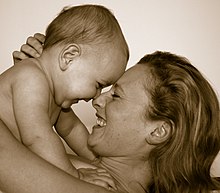Social smile
In developmental psychology, the social smile (also: smile on one's face) describes the innate ability of an infant to react to its surroundings - especially to faces - with a smile .
Most infants develop this ability around six to eight weeks after their scheduled due date. From birth, they show an increased attention to faces (but also to masks). In addition, newborns can imitate certain facial expressions with a significant delay (for example a tongue that is stuck out).
There are different theories about the meaning of the social smile - but it is clear that it is an important ability to interact with other people and thus actively build relationships and bonds . Hearty laugh can infants approximately from the fourth month of life.
Certain disorders can cause a child to forget the social smile. This phenomenon can often be observed in West syndrome , a special form of early childhood epilepsy . After successful treatment, the ability returns.
A diagnostically important criterion for early childhood autism is u. a. that a child does not develop a social smile.
